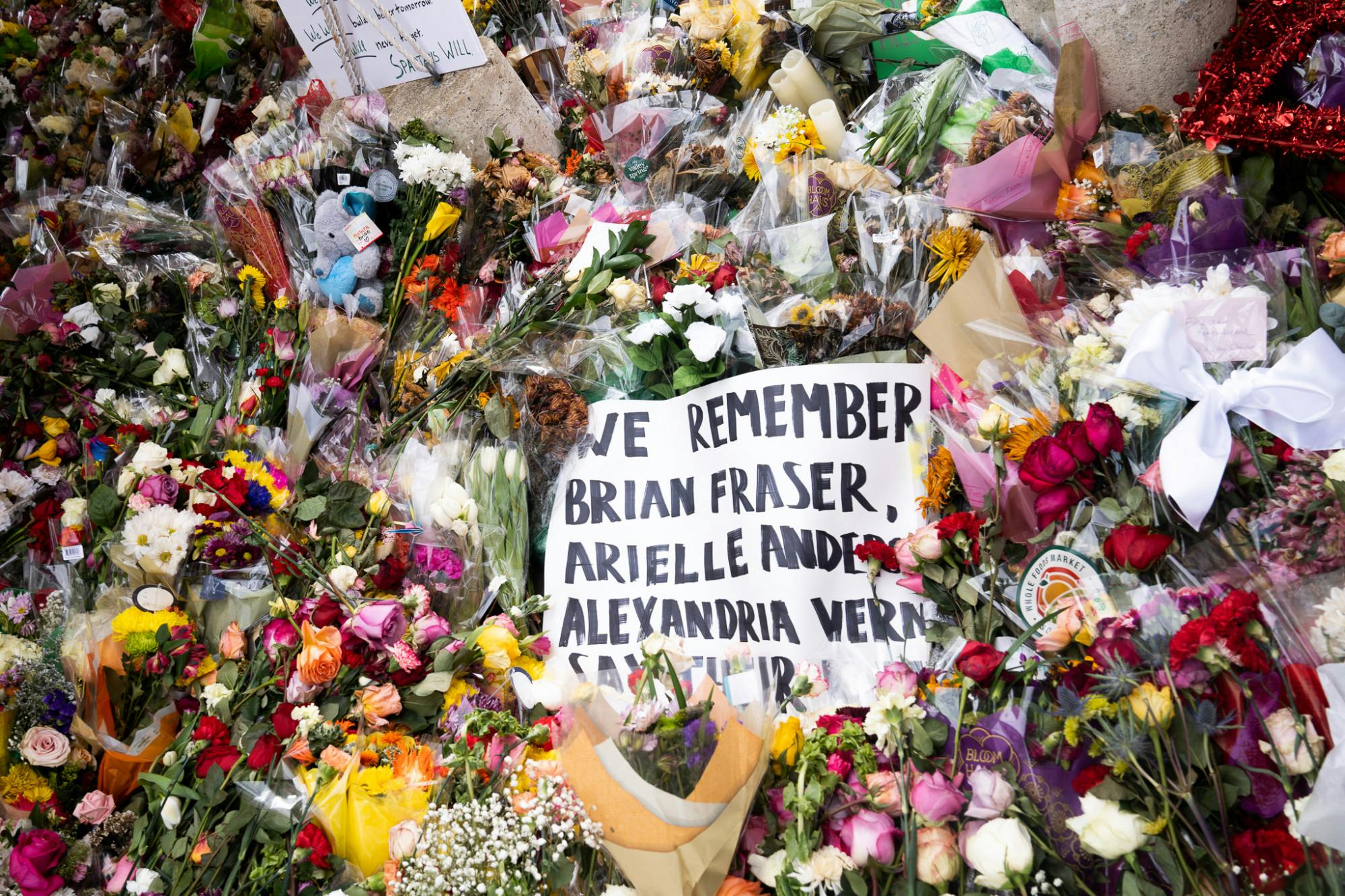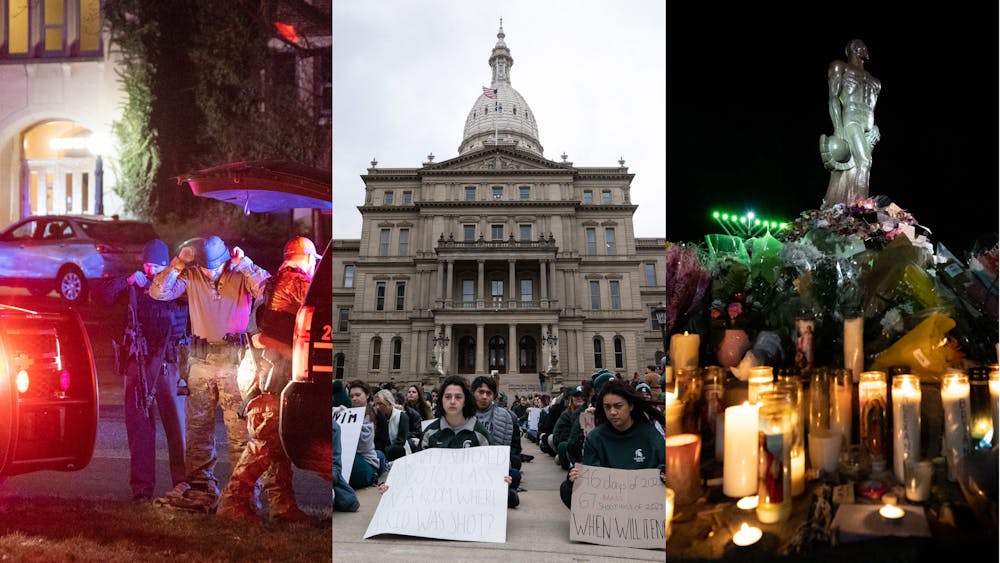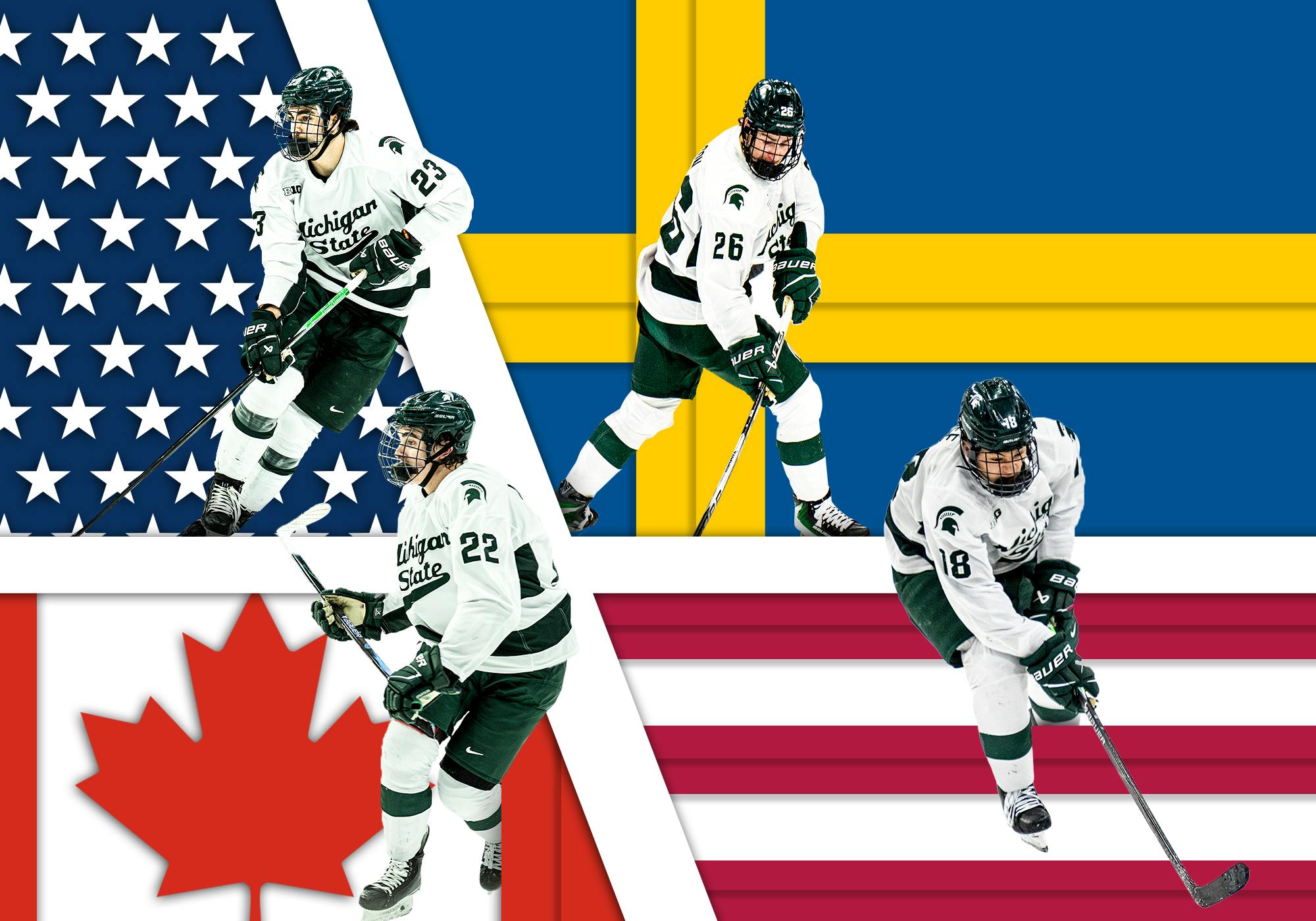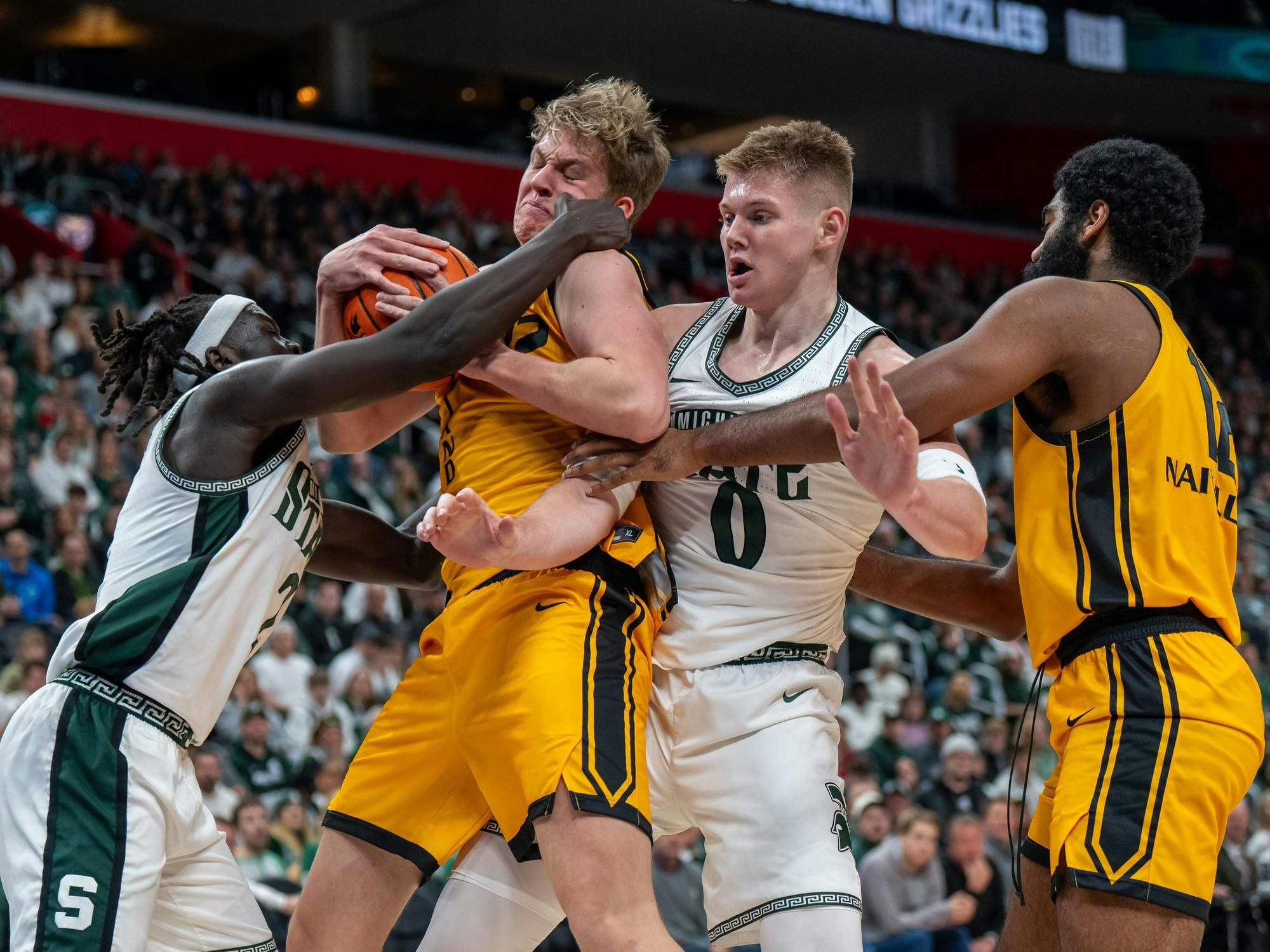| Content warning: Some descriptions and images in this story are graphic and may be upsetting or disturbing for readers. |
We covered the shooting on MSU’s campus from the scene, spending hours outside the Union and in a nearby safe room.
By the next morning, the story of what happened that night became simple to the nation: three dead, five wounded in shooting at MSU.
With a lot of help from the national media, the events were boiled down to the tangible details: the number of fatalities, the identity and status of the shooter, the guns used, the buildings where the violence took place.
But, that distillation is a disservice to the totality of what MSU experienced that night, and what other shooting sites have experienced.
Our community lost Arielle Anderson, Brian Fraser and Alexandria Verner. We lost their irreplaceable impact on those close to them and all the good they would have gone on to do.
We lost our sense of safety. We lost sacred spaces. We lost our sense of normalcy and routine.
For a while, it felt like we lost our home.
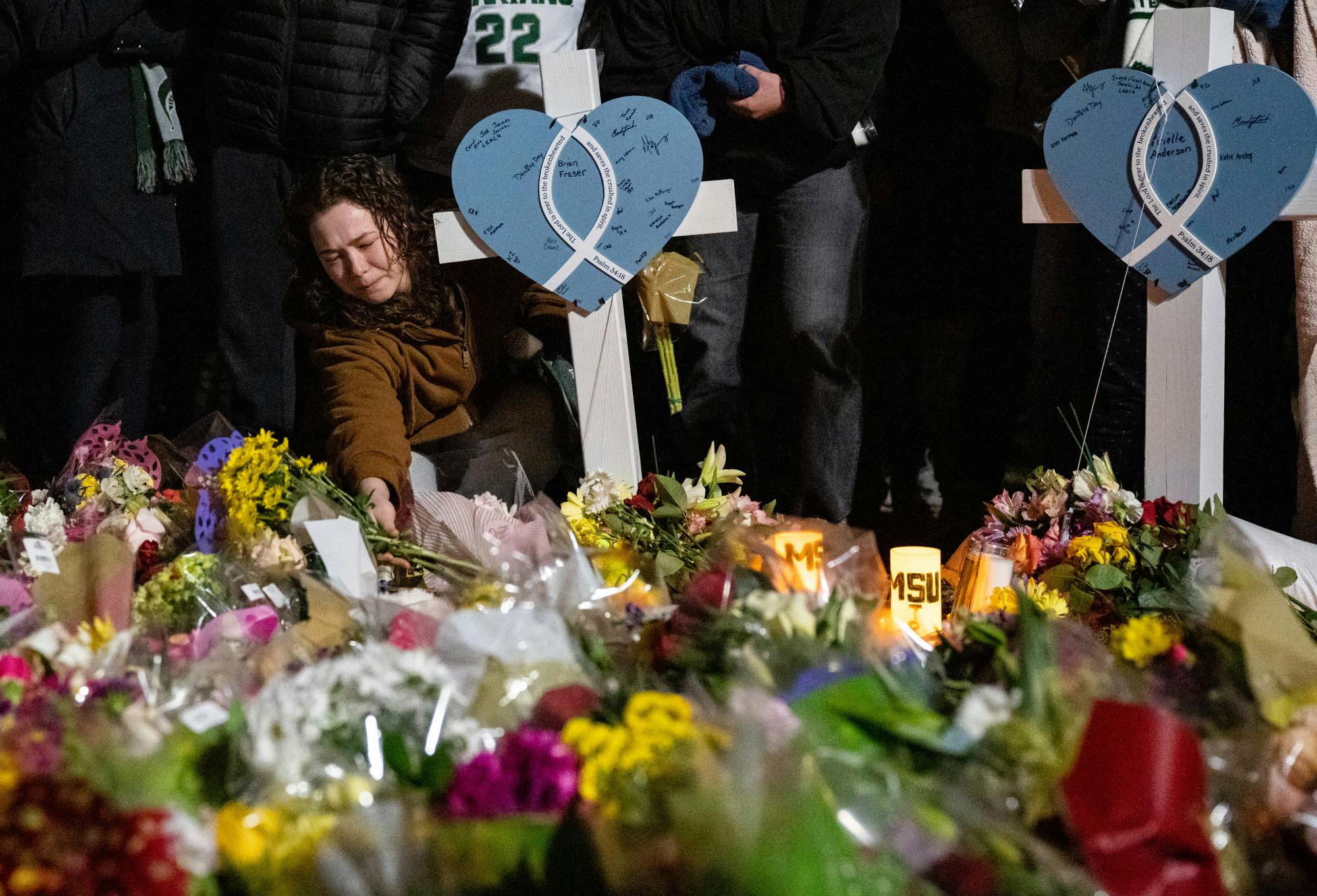
Because, these shootings are so much more holistically horrifying than any numbers can capture.
They’re a potent terrorism, creating mass hysteria and panic. They’re hours of chaos and confusion, forcing you to confront the worst kinds of questions.
We’ll never be able to capture exactly what it felt like to experience the shooting first-hand. But, after a year of reflection, we think we can get a bit closer than other accounts.
We’re three State News staffers – sports reporter Bella Johnson, photographer Audrey Richardson and news reporter Alex Walters – who experienced that night both as journalists reporting on it and students on campus living through it.
Grasping the reality
It started with a text received by a State News editor and forwarded to the staff.
“Yo there’s like 6-8 cop cars on campus by art museum/Olin area,” it said.
Alex’s editor sends a Slack message, “Alex can you bike there?”
“On my way,” he replies, leaving for the scene.
Making his way from his Case Hall dorm to the scene in North Campus, Alex came to the top of the hill on Beal Street, just past the river.
Support student media! Please consider donating to The State News and help fund the future of journalism.
Suddenly, his entire field of view was filled by blinding police lights.
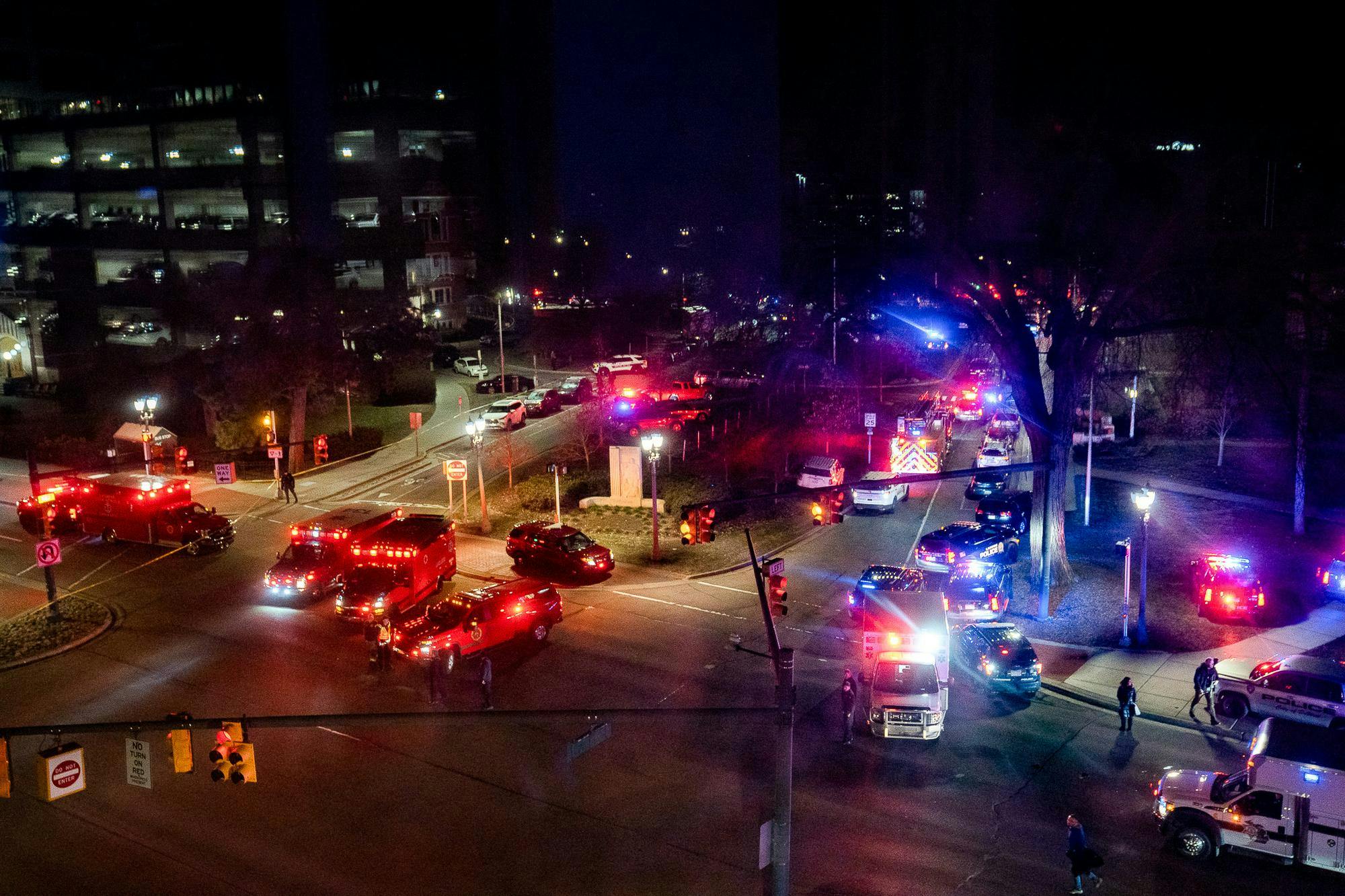
Biking closer, the scene got clearer: police raced into The Union as students rushed out.
He turned for the West Circle dorms across the street.
Someone shouted from a second-story window: “Shooter! Get inside!”
Alex ducked into Campbell Hall.
The lobby was full of students, holding each other, crying.
Most of them were employees who were working in the Union food court when the shots were fired. They were attempting a head count and coming up short, someone wasn’t accounted for.
Audrey and Bella were across campus at a club meeting.
They saw messages in an apartment building group chat describing police presence at the Union and Berkey. People were suggesting that it could be a shooting.
A State News editor suggested they check it out as they were already on campus.
The drive from the meeting at Bessey Hall to the scene at The Union was perilous, with sirens blaring and roads being closed as police scrambled to lock down the massive campus.
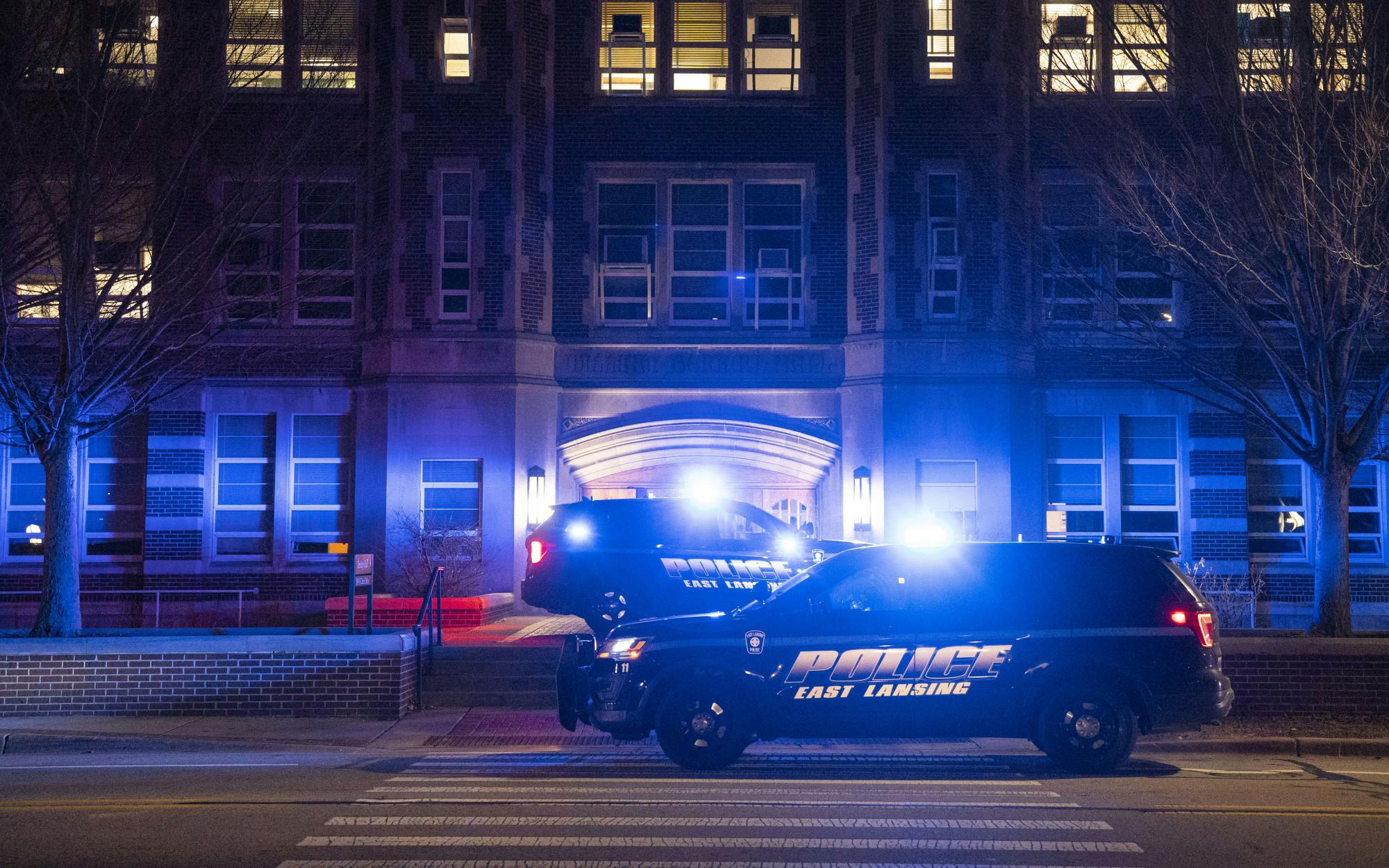
The three of us reporting on the scene that night was an odd coincidence, because a week earlier, we had been sent to Okemos High School for another reported shooting.
That turned out to be a false alarm, one in a series of elaborate, fabricated shooting reports sending schools across Michigan into hysteria.
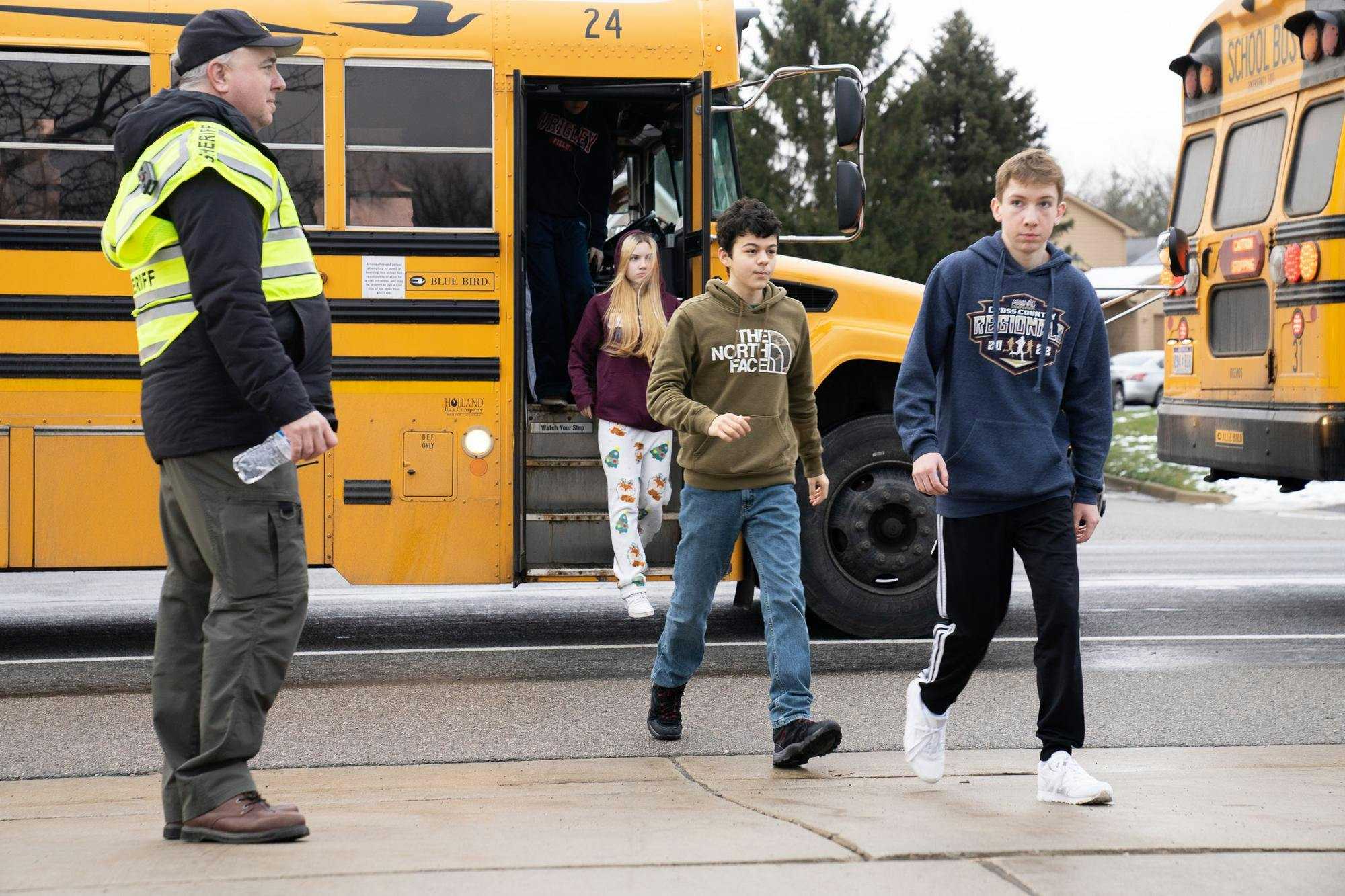
Because we had just had that experience – hearing of a shooting, going to the site, seeing the police and panicked students, then learning it was all a complex ruse – the shooting at MSU didn’t quite feel real, at least at first.
We had just seen how the widespread fear and worry could melt away so quickly; how it could all be a misunderstanding; how it all could suddenly be OK.
It would be a false alarm again, right?
Instead, it became clear to each of us that everything we were seeing was completely real.
For Alex, it was the faces of the Union employees in Campbell Hall.
He had seen fear on the faces of the students and parents in Okemos. But this was different. There was a desperation that wasn’t present before.
The students were attempting a head count, frantically texting and calling each of their colleagues.
Someone wasn’t picking up. They were thinking everyone had not made it out of the shift alive.
Audrey and Bella confronted the grim reality directly.
As they arrived at the Union, police officers made their way out, carrying someone.
As the officers carefully laid the person down on the Grand River sidewalk, there was no urgency, no rush to get help or stop bleeding. It was slow, calm, without insistence.
They realized why: the student being carried out was dead.
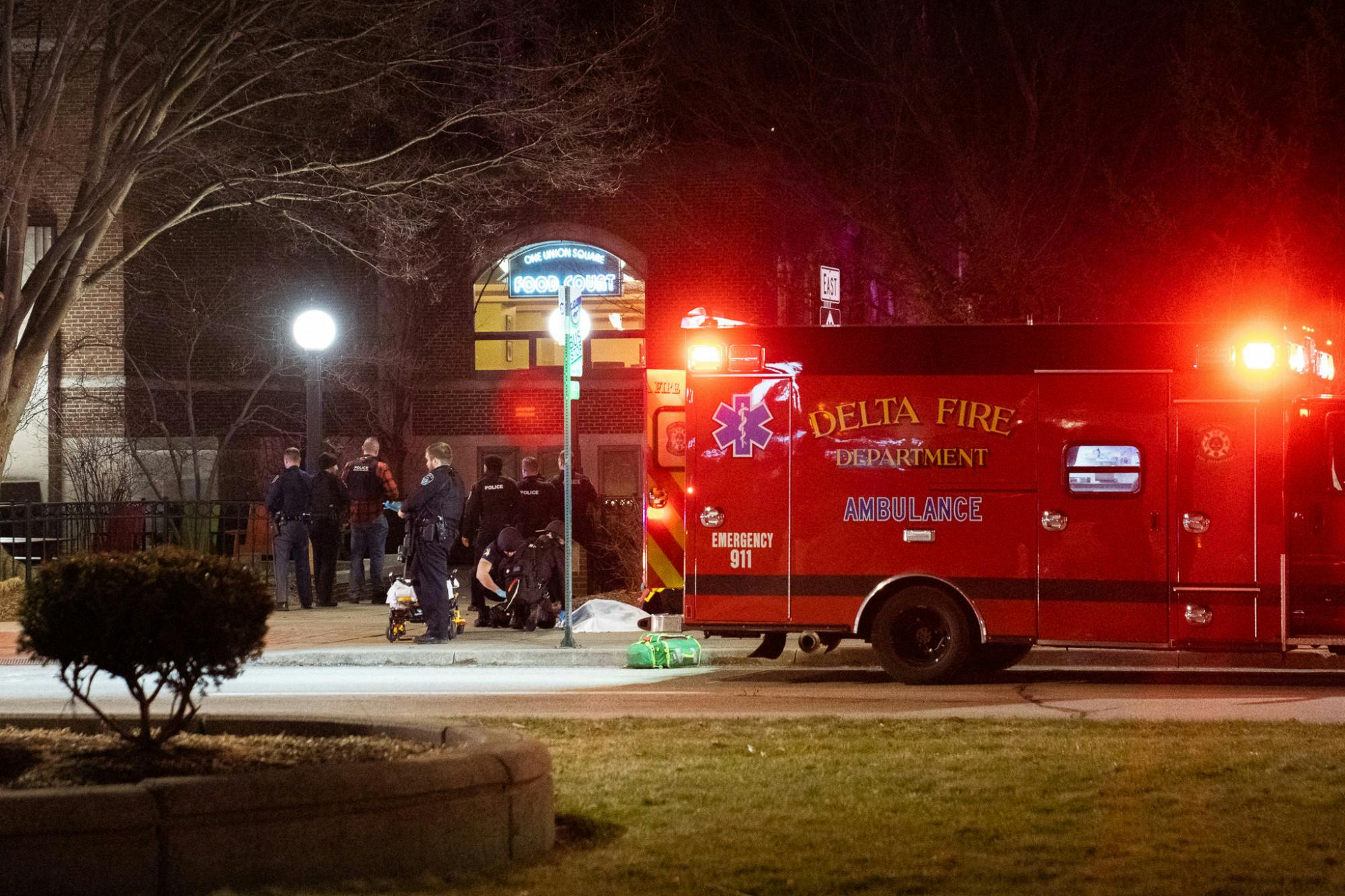
Two officers stepped away from the body, holding onto a lamp post a few feet away, gaining their balance. One officer leaned over and put his hands on his knees, spitting on the ground, as the other placed a hand on his back.
The officers spotted Bella and Audrey. They shouted, “Get out of here. There’s an active shooter.”
They made their way to join Alex in Campbell Hall.
Hours of confusion in the safe room
We were in Campbell for a little over four hours, packed into a first-floor sitting room with many of those who fled the Union.
Everyone with us had in some way directly experienced the shooting. Most were working or eating in the Union food court when the shooter opened fire. Others were in club meetings in the rooms below.
There were no questions about what was going on: this was a deadly shooting intended to inflict harm on anyone unlucky enough to receive it.
What wasn’t clear, and would remain unclear for hours, was who perpetuated it and if it was over.
At first, the room felt slow. Everyone around us was engulfed in sadness and worry, crashing from the adrenaline and fear of their flight from the Union.
Everyone was shaken up. Some among us had just escaped gunfire or seen someone get shot. There was a collective catching of breath.
“I’m surprisingly numb about it,” one student in the room told us.
But quickly, new fears set in.
The shooter opened fire in The Union just before 8:30 p.m.
Law enforcement released images of him publicly for the first time at 11:18 p.m.
They confirmed he was dead at 12:38 a.m.
In those hours between the shots fired, official identification and the shooter’s death, speculation gave way to countless theories and worries.
First, an image of three men in plain-clothes holding assault rifles circulated rapidly, prompting now disproven theories of multiple shooters.
Students around us panicked. They had seen one shooter enter and exit the Union. But could there be more lurking around? Others that could soon strike our enclave?
Then, online sleuths quickly, and falsely, identified one of the shooters.
An image of a man identified by posters as “Lynn Dee Walker” trended on Twitter and Facebook the night of the shooting, with captions that falsely claimed he was one of the armed men in the then-viral photo.
The students around us were also stirred by talk of bombs.
Scanner chatter and social media speculation first floated the word, which snowballed as the night went on.
Students constantly debated whether staying in the room was the best option.
They wondered, should we go somewhere else? Up into a dorm? Somewhere across the street, off campus? Or, are we safest here?
Law enforcement couldn’t provide much comfort.
Multiple officers came in and out of the room that night, each giving different directions.
As the various officers from various agencies each provided their uncertain insight on where we should go, it became clear that they knew little more than we did.

A police officer searches marketing freshman Collin Gaffke as officers and FBI agents yell at students to put their hands above their heads as they search every person inside of Campbell Hall, the building across from the MSU Union on Feb. 13, 2023. This image was taken at 11:07 p.m., almost four hours after the attacker had taken the lives of three students and fled MSU's campus.
The fear was also by no means contained to our group in Campbell.
The online rumor mill and unreliable, but widely consumed, police scanner chatter seemed to touch every corner of campus, creating panic over now-disproved reports of further violence.
Just before 9 p.m., scanner chatter mentioned reports of the shooter and shots fired near Snyder/Phillips Hall.
Within minutes, a State News reporter who was barricaded in her Synder dorm sent a Slack saying, “I think the shooter is in my building.”
“I heard a gunshot,” she said. “I locked myself in my room.”
Social media posts soon reported that Snyder/Phillips was one of the buildings where shots were fired.
But, the shooter was never inside Snyder/Phillips, according to the official law enforcement timeline.
Half an hour later, students were fleeing Akers Hall after scanner traffic described reported gunfire there.
Again, the shooter was never inside Akers, according to the official law enforcement timeline.
We now know that the violence that night was contained to Berkey and the Union. But during those hours, we in the Campbell safe-room and students across campus were routinely sent into panic by reports of further shooting elsewhere.
A different chaos outside
Audrey, a photographer, felt restless inside Campbell. She decided to head back outside.
At first, it was eerily quiet. No more crying and phone calls and chaos and confusion. There wasn't a single car passing her on Grand River, which is ordinarily highly-trafficked at all hours of day and night.
The brief tranquility was oddly comforting.
Soon though, the campus was completely basked in blue and red lights as hundreds of law enforcement officers from over 72 agencies descended on East Lansing.
Each time the scanner chirped, announcing a new reported sighting, Audrey heard heavy footsteps from officers rushing passed in various directions.
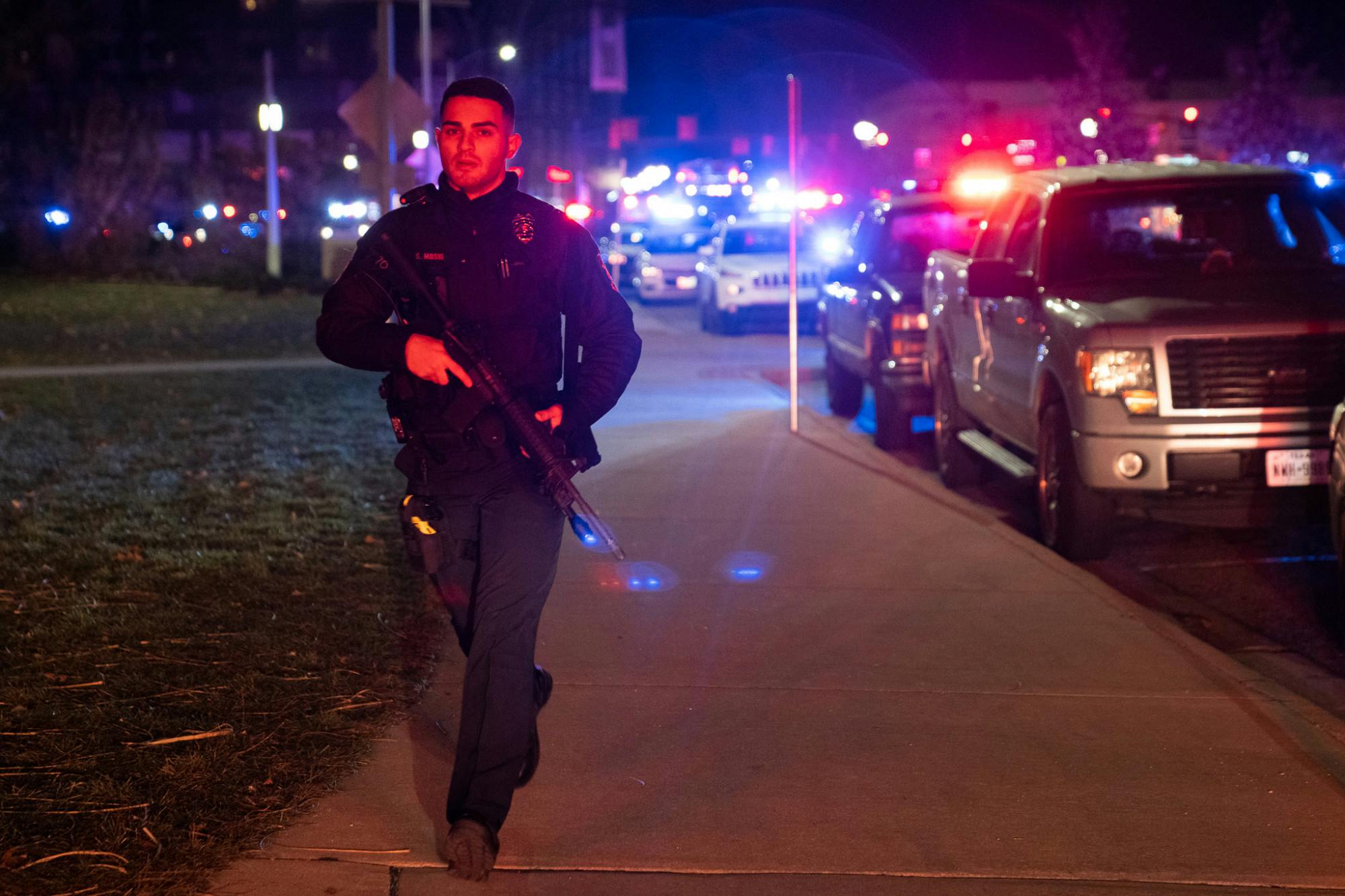
A police officer responds to a call across campus outside of MSU Union during the response of a shooting on Michigan State’s campus on the night Feb. 13, 2023.
An ambulance operator told her that law enforcement, like students, were confused and worried.
He said officers were stretched thin, “chasing down everything, bogus or real.”
“There’s so many rumors going around right now,” he said. “It’s crazy … everybody’s calling in everything.”
She wasn’t the only civilian outside.
A parent stood for hours outside the Union, waiting for an all-clear so that their daughter – who was sheltering inside – could come out.

Police officers make their way into MSU Union in full tactical gear to secure the building in full tactical gear during the response of a shooting on Michigan State’s campus on the night Feb. 13, 2023.
A swift end
The chaos of the night ended quickly, with reports from the scanner saying the shooter had killed himself during a stand-off with the police miles from campus.
After hours of false reports, no one was sure if that should be trusted. It seemed surreal that those nightmarish hours could be over so suddenly.
We approached one of the officers in the room and asked, “Is it true?”
He looked around like he wasn’t supposed to say anything, but eventually gave a stern nod, confirming the shooter was dead.
Membership in the saddest club
We grew up with school shootings. We were, in a way, waiting our whole education for it to happen.
Sandy Hook was when we, like the children murdered there, were in elementary school. Parkland was when we, like the children murdered there, were in high school.
Countless others occurred throughout our education, each time bringing about the same headlines and the same worries.
Active shooter drills were regularly scheduled. Clear backpacks or ballistic windows were debated by our school boards.

Bullet holes remain in Berkey Hall's Room 114 on Feb. 16, 2023.
We always thought that we got it. That with all that exposure to and preparation for this tragic phenomenon, we understood what it was.
That was disproven by the first major shooting after our own.
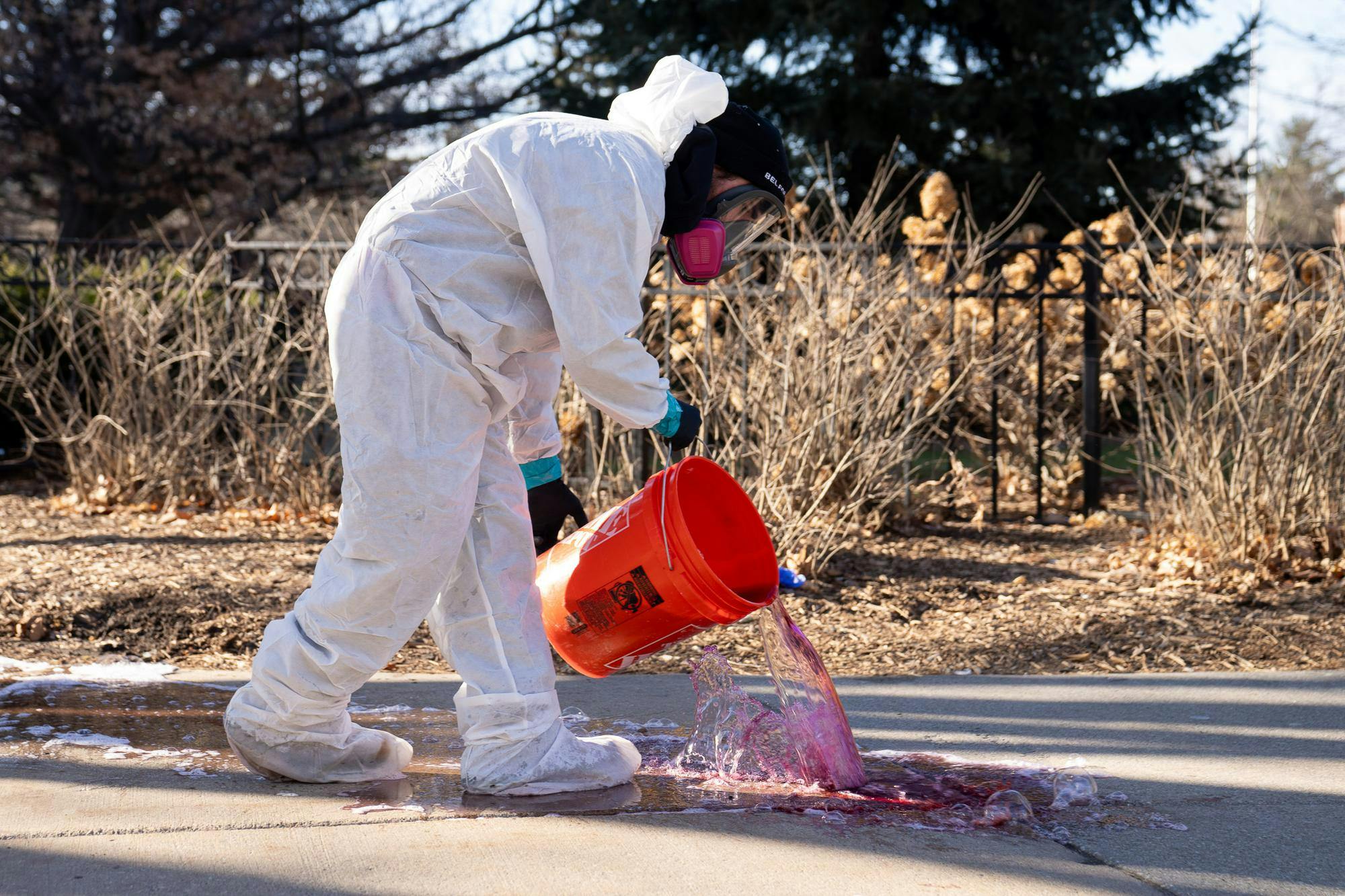
An official in a hazmat suit cleans blood off of the sidewalks on campus on Feb. 14, 2023. The clean-up took place the day after the MSU community faced a mass shooting.
A little more than a month after the shooting at MSU, children and teachers were killed in a mass shooting at The Covenant School in Nashville, Tennessee.
When we read about Covenant, there was a newfound understanding. We knew that beyond the tragic loss of life, a whole community had been terrorized and traumatized.
We knew about the eerie feeling of the weeks after. The feeling that everything was different, the unimaginable thoughts of a return to normalcy, and the guilt in moments where we got close.
In September 2023, Alex was at a trauma journalism conference at Franklin College, a part of a panel with other journalists and educators who had covered or experienced school shootings.
Chatting after the panel, Alex noticed that he and the other panelists could communicate easily about what happened.
One of them told Alex he has “a membership to the saddest little club, and it’s very tight-knit.”
There’s an odd universality to these tragedies.
Another part of that comment sticks out to us, too.
Is it really “little?” Or is the club an ever-expanding circle, a growing and seemingly unending part of American life?
We heard about shooting after shooting our whole childhoods. Then we experienced our own.
Since then, we keep hearing about them, and now do so with a fuller sense of everything numbers can’t capture.
